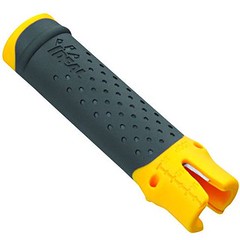One aspect of DIY home renovation that I really truly enjoy is doing electrical work. I’m not sure why this is, perhaps it’s the analytical way you need to think about doing electricity, or maybe it’s because it feels like you’re getting to the end of a project and the lights make the work come alive. Whatever the case, I just feel like I get into the groove with electrical work and just like doing it, but there are some drawbacks, especially with how my hands feel in the days after I finish the work. Much to my relieve, I recently found a tool that has largely solved these issues.
When I was working construction in college, the general contractor and electrician I was working for was always complaining about the beating his hands had taken over the years of doing construction work, and especially electrical work. Whether you’re cutting, twisting, stripping, crimping, splicing, or terminating, you’re using your hands in ways that put a lot of stress on your fingers in very tight spaces.
I feel like using a good pair of Mechanix work gloves when I do electrical work helps my fingers take less of a beating. However, I still hate the process of stripping the plastic jacket off of romex and also of getting the right bend on the end of a wire to loop it over a screw post. Both of these items constantly had me removing my gloves to pull, tug, maneuver or whatever else was necessary, leaving my hands wishing for a better solution.
About a year ago, while in our local Ace Hardware, I randomly came across this great little device called the "Lil' Ripper Stripper" in the electrical supply aisle. I don’t even know why I looked at it other than because it was yellow (they got me), but then I noticed what it was. This device turned out to be an all in one electrical work helper. Just check out all of secondary uses for this little dynamo.
- The exterior of the tool has a rubber grip and several markings to help with strip depth and gauge measurement.
- There are a bunch of small holes on the exterior that allow you to slip the end of stripped wire through them to give you the perfect curl to mount wire over screw terminal posts on switches or plugs. No more wrestling with needle nosed pliers to constantly adjust the size of the curl because it was too small or too large.
- Fitting the end over a wire nut with wings let's you get a better grip to twist, saving your fingers once again.
But the best part is the small metal hook that sits on the side of the hollow interior. This little blade works to hook the edge of the plastic sheath covering of romex wire and lets you easily and safely slide the tool up the wire cutting as you go. Just slip the tool off when you’re done and you’ve got yourself bare wires with the jacket removed. Just turn the tool over to cut the excess jacket with the tool's bladed notch and you’re good to go. No more bothering with those cumbersome metal tools with the little tooth hanging down, always worrying that you’re going to cut the inner jacket of the wires beneath the covering.
For such a simple and inexpensive device, I really can’t believe I took so long to both find and buy it. How this would have made our early days on the renovation easier, not to mention my construction work in college.
Do you have a similar tool that you use? Or maybe you just have a preferred method of electrical work that doesn’t leave your hands beat to hell for days after you’re done?
Did you enjoy reading this post? Want to learn more about our first-hand experiences with other tools, devices or items used throughout our renovation? If so, check out our complete list of product reviews in our Toolbox Tuesday section.
Note: We weren't compensated for this review. We simply want to share good products when we see them, and hope that learning from our mistakes can help save you time, money and frustration.

![]()
![]()